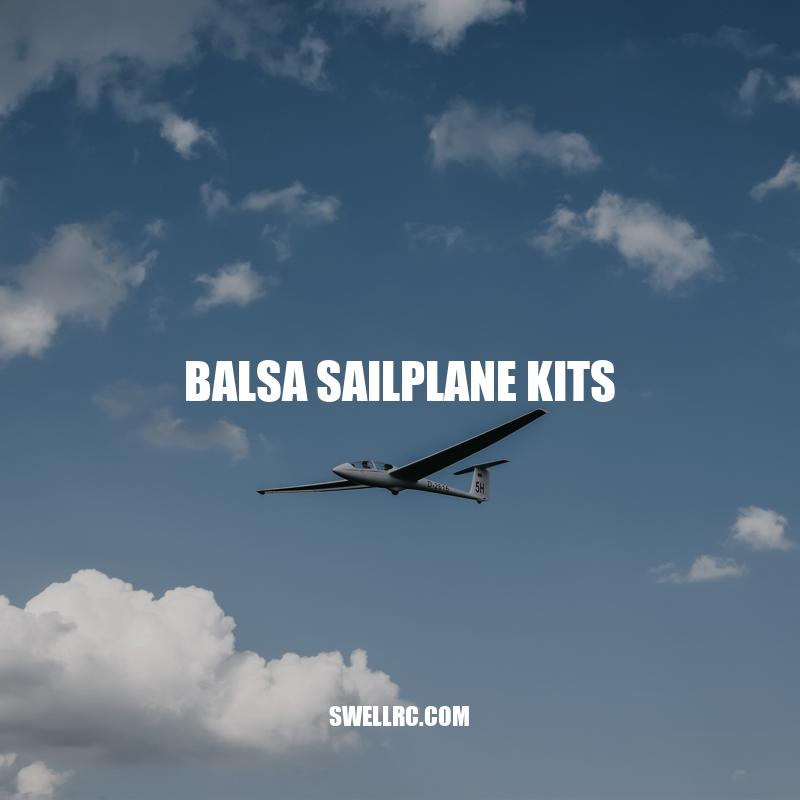Build and Fly Balsa Sailplane Kits: A Fun and Easy Hobby
Balsa Sailplane Kits: Lightweight and Fun to Fly
If you’re a fan of aviation or model building, or simply looking for a new and rewarding DIY project, building and flying a balsa sailplane kit could be just the thing for you. Balsa sailplane kits are affordable and accessible options for those looking to explore the world of model aircraft. They’re lightweight and highly maneuverable vehicles, which are designed to have minimal motorized power, instead, relying on rising air currents to stay aloft. The kits come with pre-cut balsa wood pieces, carbon fiber spars, fittings, and glue, everything that one needs to build models ranging in size from small to very large with wingspans of over 5 feet. These kits are often readily available in hobby stores and online, and provide a great opportunity for enthusiasts to express their creativity and explore the physics of flight while producing a tangible outcome. Building and flying a balsa sailplane kit is a hands-on experience in which you can learn mechanics and aerodynamics while having fun and satisfying your curiosity. Besides, a balsa sailplane kit requires only a basic skill set and some time.
Building a Balsa Sailplane Kit: A Step-by-Step Guide
If you’ve decided to give building and flying a balsa sailplane kit a try, be prepared to devote some time and attention to the process. Here’s a general outline of the steps involved:
Materials and Tools
- A balsa sailplane kit
- Sandpaper (at least 220-grit)
- A hobby knife or razor saw
- Glue (preferably cyanoacrylate or white glue)
- A cutting mat or a flat surface
- Clamps or rubber bands
- A ruler or caliper
- Paint (optional)
Instructions
- Read the instructions carefully. Identify the pieces and their numbers.
- Gently remove the parts from their sheets and sand the edges lightly to remove any rough spots.
- If needed, cut some pieces to size using the hobby knife or saw. Use a cutting mat or a flat surface to avoid damaging the parts or the table.
- Follow the instructions to assemble the fuselage, the wing, the tail, and the control surfaces. Use clamps or rubber bands to hold the parts together while the glue dries. Double-check that everything is aligned and flush before gluing.
- Apply decals or paint to add details or customize your sailplane.
- Balance your sailplane by placing it on your fingers at the center of gravity. Adjust the weight by adding or removing ballast or moving the battery.
- Test your sailplane by throwing it gently into the air or launching it from a slope or a winch. Adjust the control surfaces if necessary.
- Have fun flying your sailplane at your local park, a flying field, or a slope soaring site.
In the second paragraph, provide a detailed guide on how to build a balsa sailplane kit. Divide the guide into subheadings such as “Materials and Tools” and “Instructions” and use bullet points or numbered lists for each step. Highlight the importance of following the instructions precisely and using the right tools and techniques. Mention some common challenges or mistakes and ways to avoid them. Link to some online tutorials or videos that showcase the process. Provide affiliated links to some reliable websites or products, if necessary. Use keywords such as construction, techniques, components, adjustment, testing, tools, safety, and customization.
How do you make a simple balsa wood glider?
Making a balsa wood glider is a simple and fun project for anyone who enjoys DIY projects. Balsa wood is a lightweight and easy to carve material that is perfect for making gliders. Here is a step-by-step guide on how to make a balsa wood glider:
Materials needed:
– Balsa wood sheet
– Glue
– Sandpaper
– Razor blade
– Ruler
– Pencil
– Scissors
– Paper clip
– Thread
Step 1:
Draw the outline of the glider on the balsa wood sheet using a pencil and ruler. Make sure the wings and tail are properly proportioned. Cut out the outline using a razor blade or scissors.
Step 2:
Sand the edges of the glider pieces with sandpaper to smooth them out. This will also make the surface of the wood rough enough for the glue to adhere.
Step 3:
Glue the wings to the body of the glider using wood glue. Let it dry for a few minutes.
Step 4:
Attach the tail to the body of the glider using wood glue. Let it dry for a few minutes.
Step 5:
Bend a paper clip to create a hook shape. Poke a small hole in the nose of the glider and insert the hook into the hole.
Step 6:
Tie a thread around the paper clip hook. Hold the glider by the thread and gently toss it into the air. Watch as your balsa wood glider glides gracefully through the air.
Making a balsa wood glider is an enjoyable way to spend an afternoon. With a bit of patience and creativity, you can create a glider that will soar through the air for hours. Enjoy the process and happy flying!
Balsa Sailplane Kits: A Selection of Options
Now that you know how to build a balsa sailplane kit, let’s take a look at some of the popular kits that are available for purchase. Here are five examples, along with their features and approximate prices:
| Kit | Wingspan | Skill Level | Features | Price |
|---|---|---|---|---|
| Sig Riser 100 | 100 inches | Intermediate | 2-channel radio control, balsa wood and ply construction, thermal soaring | $199.99 |
| Great Planes Spirit | 78 inches | Beginner | Pre-covered balsa frame, polyhedral wing for stability, simple assembly | $84.99 |
| Carl Goldberg Gentle Lady | 78 inches | Beginner | Pre-cut balsa construction, self-launch or tow, steady flight performance | $89.99 |
| Sky Bench Aerotech Sailplane | 118 inches | Advanced | Laser-cut interlocking balsa pieces, winglets, ballast system, aerobatic capabilities | $329.95 |
| Top Flite Monokote | 100 inches | Intermediate | ARF kit with pre-covered and painted parts, cantilever wing, fiberglass fuselage reinforcement | $359.99 |
In the third paragraph, provide a table and a brief description of some of the balsa sailplane kits that are popular among hobbyists. Include information about their wingspan, skill level, features, and approximate prices. Emphasize their differences and their suitability for different preferences and experiences. Mention some interesting facts about these kits, such as their historical or competitive significance, or their ability to perform aerobatics or thermal soaring. Offer some links or references to websites or catalogs where the reader can purchase these kits. Use keywords such as models, brands, design, performance, prices, features, and functions. For example, visit https://sigmfg.com/products/sigriser100kit for the Sig Riser 100 kit, or https://www.greatplanes.com/discontinued/gpma0530.html for the Great Planes Spirit kit.
Balsa Sailplane Kits: Tips for Flying
Once you have built your balsa sailplane kit, it’s time to take it to the sky! Here are some tips for flying your sailplane:
- Choose a calm and clear day for your first flights.
- Find a location that offers some lift, either from a slope or from a thermal.
- Make sure the sailplane is balanced and the control surfaces are aligned and functioning properly.
- Look for visual cues of lift, such as soaring birds or rising air currents.
- Launch the sailplane gently but firmly, using a hand or a bungee cord or a winch, depending on the design and your preference.
- Avoid pulling up sharply or stalling the sailplane, which can cause it to lose altitude or spin.
- Practice using the controls smoothly and gradually, and adjust the elevator and the ailerons to achieve the desired flight path and speed.
- Try to stay in the lift as long as possible, using your skills and your instincts to navigate and exploit the air currents.
- Prepare for landing by reducing the speed, lining up with the landing strip or the designated spot, and flaring the sailplane to reduce its descent rate.
- As you gain more experience and confidence, try to fly in different conditions and locations, and experiment with different techniques and strategies.
In the fourth paragraph, provide a list of tips for flying a balsa sailplane, using bullet points or numbering. Cover the basics of launching, soaring, steering, and landing. Offer some dos and don’ts that can help the reader avoid common mistakes and accidents. Use keywords such as lift, launch, controls, landing, techniques, conditions, and safety. Mention some websites or videos that offer further instructions or demonstrations on flying a sailplane. Provide some interesting facts about sailplane flying, such as the world records for altitude and distance, or the gliding competitions held around the world.
How can I make my glider fly better?
Improving the flight of your glider is a task that requires careful experimentation and observation. Thankfully, there are a number of changes you can make to boost the performance of your glider and keep it soaring through the sky. Here are a few tips on how to make your glider fly better:
First and foremost, adding weight to your glider can make it a more stable and efficient flyer. The easiest way to achieve this is by using higher density balsa wood in your construction. This type of wood tends to be stiffer and stronger, giving your glider more structural integrity and improving its overall performance.
Another option for increasing the strength of your glider is to make the wings thicker. This added thickness gives your glider more surface area to generate lift, which can help it gain altitude and stay in the air for longer periods of time.
Aerodynamics also play a key role in the performance of your glider. Ensuring that your glider is properly designed and balanced can help reduce drag and improve its overall efficiency. For example, reducing the amount of air resistance on the glider by tapering the front and rear of the wing can improve its overall glide ratio.
Finally, keep in mind that the weight of your glider is also a factor in its performance. Be sure to consider weight when selecting materials and during construction. A lighter glider will typically be easier to launch and fly, but may not have the same level of durability and strength as a heavier glider.
In conclusion, by carefully considering the materials, design, and weight of your glider, you can make important changes that will improve its performance and keep it soaring through the skies. With a bit of experimentation and observation, you can find the perfect balance of strength and aerodynamics for your unique glider design.
Balsa Sailplane Kits: Enjoy the Thrill of Flight
Whether you are a beginner or a seasoned pilot, building and flying balsa sailplane kits can bring you hours of joy and educational experiences. Not only can you learn about aerodynamics and craftsmanship, but you can also explore the beauty and serenity of the sky. A sailplane kit can be a great gift for a young person interested in science or engineering, or for an experienced modeler looking for a new challenge.
Moreover, sailplane kits are relatively affordable and eco-friendly, as they use sustainable materials and require no fuel or batteries. They can be stored easily and transported to different locations, allowing you to enjoy the outdoors and the social interactions that come with this activity. You can meet other hobbyists, join a club, participate in a contest, or simply appreciate the view from above.
Additionally, flying a sailplane can be a form of meditation and relaxation, as it requires concentration and mindfulness. It can also boost your self-confidence and your problem-solving skills, as you overcome obstacles and fine-tune your techniques. You can customize your sailplane to reflect your personality and creativity, by painting it, adding decals, or experimenting with different designs.
In conclusion, balsa sailplane kits are a fascinating and accessible way to explore the world of aviation and craftsmanship. They offer a wide range of benefits, from educational to recreational, and anyone can enjoy them with some dedication and practice. So why not give it a try and see where the wind takes you? Happy soaring!
Use a second-level header (



